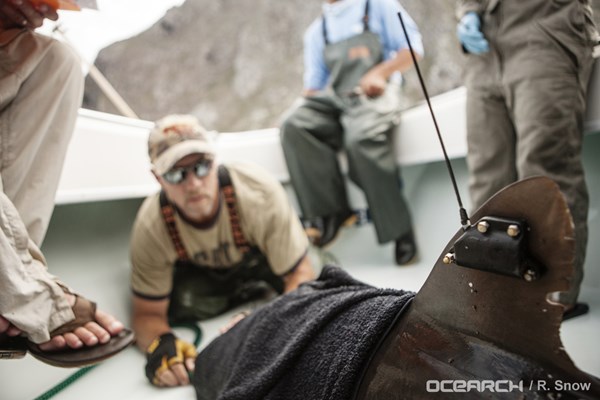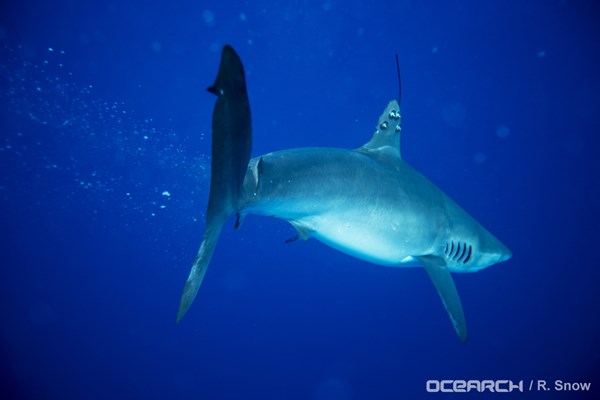PARK CITY, Utah, Nov. 4, 2014 (GLOBE NEWSWIRE) -- Science and Management work together to ban long-lining in Galapagos – issue highlighted by killing of shark in marine reserve
Modern technology and sophisticated ocean science have generated pivotal data supporting the Galapagos National Park Directorate in its decision to order greater restrictions on an artisanal fishing practice that threatened endangered species in the Galapagos Marine Reserve.
In January 2014, a joint expedition by OCEARCH, the Charles Darwin Foundation, Turtle Island Restoration Network, and the Galapagos National Park Directorate tagged sharks and other fish species with satellite transmitters. The research team's goal was to understand how marine reserves, with restrictions on fishing, contribute to the conservation of key species in the world's oceans.
Six months later, one of the tagged sharks, a 215cm (7 foot) adult female silky shark, was caught by artisanal fishermen inside the Galapagos Marine Reserve. The shark, nicknamed "Fernanda" and traceable on the website http://www.ocearch.org, belonged to a species that is highly prized for its fins. Near Galapagos and elsewhere in the Eastern Tropical Pacific, they are among the most heavily fished sharks, and their regional population is classed as "Vulnerable" on the IUCN Red List.
"Fernanda should have been safe within the borders of the Galapagos Marine Reserve", says Alex Hearn, Conservation Science Director for Turtle Island Restoration Network.
Instead, she fell victim to a method of fishing that is known to produce a significant amount of by-catch, in the very zone that was set up to protect her and at a time when this method should no longer have been in use.
Industrial-scale fishing has been banned in the waters around Galapagos since 1998 with the creation of the Galapagos Marine Reserve. However, the local population of fishermen has permission for an artisanal fishery, a practice that can help to create sustainable local livelihoods if applied properly. Until recently, under a year-long pilot project scheme, the use of a mid-water long-lining was allowed, a type of gear that often catches a high percentage of fish that are not the fishermen's target species.
After the end of the pilot project in December 2013, the Galapagos National Park Directorate presented its report. The complementary socio-economic report to be presented by the Santa Cruz fishing cooperative was delayed. On the basis of this, on June 12th, the Galapagos National Park Directorate put a halt on the use of this type of fishing gear, which caught Fernanda.
Dr. Pelayo Salinas de León, the fisheries expert of the Charles Darwin Foundation, added: "Over the past two decades, several pilot studies by the Galapagos National Park Directorate, the Charles Darwin Foundation and the Ecuadorian National Fisheries Institute have shown that a large proportion of the catch from these long-lines were sharks, not the tuna that were the actual target of the fishermen. Despite these clear results, that led to a total long-lining ban in the reserve in 2005, another pilot project was allowed in 2012 to see if a mid-water long line was ecologically compatible within the Galapagos Marine Reserve."
"The Galapagos National Park Directorate was able to take swift action based on the sound scientific data we delivered to them," said OCEARCH Founding Chairman and Expedition Leader Chris Fischer. "It's powerful when you see a study prove that sharks are being taken in a UNESCO World Heritage site.
It's equally powerful to see that our scientific work leads to action by the managers of these protected waters. We are proud to have been able to bring clarity about this subject and to have directly contributed to the removal of long lines from the Galapagos Marine Reserve."
"A shark caught for its fins is worth $100. A shark in a healthy eco-system that attracts tourism, such as divers, can be worth up to $2.5m, as studies have shown. The additional protection implemented by the Galapagos National Park Directorate is commendable", added Swen Lorenz, Executive Director of the Charles Darwin Foundation. "It will benefit the sharks and other species and their marine ecosystem as well as leading to improved experiences for visitors, from all over the world, in the Galapagos."
At the same time that Galapagos National Park was strengthening protection for sharks in the Galapagos Marine Reserve, Ecuador joined the European Union, Costa Rica, and Egypt in formally proposing that six of the world's most at-risk shark species be listed under the international Convention on the Conservation of Migratory Species of Wild Animals (CMS). These species, including silky sharks like Fernanda, could soon benefit from enhanced international cooperation to help them avoid extinction. Final decisions on whether to list these species will be made at the CMS Conference of the Parties in Quito, Ecuador, from November 4 to 9, 2014.
ABOUT OCEARCH
OCEARCH is a non-profit organization with a global reach for unprecedented ocean-based research on apex predators such as Great White Sharks, supporting leading researchers and institutions seeking to attain groundbreaking data on the movement, biology and health of sharks to protect their future while enhancing public safety. The researchers OCEARCH supports work aboard the M/V OCEARCH, a 126' Cat-powered vessel equipped with a custom 75,000 lb. hydraulic lift and research platform, which serves as both mother ship and at-sea laboratory.
OCEARCH expeditions, sponsored in large part by Caterpillar Inc. as part of a socially innovative multi-year partnership to facilitate data that is in turn shared on the Global Shark Tracker with the world for free - enabling students and the public to learn alongside PhDs. The Global Shark Tracker is a web-based near-real-time satellite-tracking tool for sharks that will eventually be expanded to other species. Additional partnership support is provided by Costa Sunglasses, Contender, Yamaha, SAFE Boats, MUSTAD and Landry's Inc.
ABOUT THE CHARLES DARWIN FOUNDATION
The Charles Darwin Foundation for the Galapagos Islands (CDF) is an international organization that provides scientific research and technical information and assistance to ensure the proper preservation of the Galapagos Islands. For fifty years, CDF has worked closely with the Galapagos National Park Directorate, providing the results of scientific research to conserve this living laboratory. Dr. Pelayo Salinas and David Acuña are currently leading the fisheries research program at CDF. The former has ample experience in the use of genetics to determine movement of marine species, whereas the latter is responsible for the maintenance of the underwater array, and has been involved in shark tagging expeditions for the last two years. Both researchers also have ample experience in acoustic tagging of coastal and pelagic fish species.
ABOUT TURTLE ISLAND RESTORATION NETWORK
Turtle Island Restoration Network works to mobilize people and communities around the world to protect marine wildlife, the oceans and the inland waterways that sustain them.
ABOUT THE GALAPAGOS NATIONAL PARK DIRECTORATE
The Galapagos National Park Directorate is responsible for the conservation of the ecological integrity and biodiversity of island and marine ecosystems of the protected areas of the archipelago, as well as a rational use of the goods and services they generate for the local communities. Eduardo Espinoza is a Marine Biologist who has worked in the Galápagos Islands since 1991. He is the coordinator of Marine Research at the Galapagos National Park Service, and has been involved in the shark research program since 2007.
Photos accompanying this release are available at:
http://www.globenewswire.com/newsroom/prs/?pkgid=28801
http://www.globenewswire.com/newsroom/prs/?pkgid=28802

